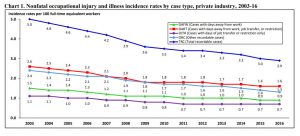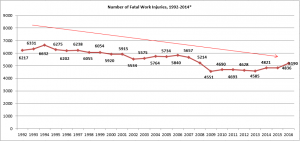Safety Anomalies Are Often Hidden in Plain Sight
08/17/2018

Sometimes, safety anomalies are hidden in plain sight. We see the data, we think we understand the data, but we don’t always ask the right questions about it and that can keep us from challenging our preconceptions about safety.
Since this week is OSHA’s Safe + Sound week and employers in the United States are showing their commitment to worker safety, it’s a good time to take a closer look at a particularly puzzling safety anomaly, and its implications for how we are managing risk.
The Data
First, let’s take a look at an aspect of occupational safety that most people are already familiar with. This first chart is from OSHA’s most recent injury and illness news release, which includes data collected via the Survey of Occupational Injuries and Illnesses (SOII) through 2016.
Do you see that dark blue line on the top of the chart? It shows the overall trend in the population-adjusted rate (per 100 full-time equivalent workers) of nonfatal injuries and illnesses between 2003 and 2016, and we can clearly see that it is trending downward. The rate was reported to be 5 in 2003, and to be 2.9 in 2016, with the number either declining or remaining relatively steady each year in between.
Now let’s take a look at the second chart below, which shows statistics from the Bureau of Labor Statistics (BLS) on the number of fatal work injuries reported from 1992 to 2016.
Notice that there is a general downtrend in the total number of occupational fatalities, which is what we’d expect (and hope) to see. So far, so good, right? Certainly, at least until we look at the right side of the graph containing the final 5 data points from 2012 to 2016. There were 4628 fatalities reported in 2012, but the number of fatalities actually increased to 5190 in 2016. In fact, the number of fatalities rose every year during the final three years in this period!
The trend remains when we look at population-adjusted fatality rates, like those presented in the chart on page 2 of this BLS document. The occupational fatality rate increased from 3.4 fatalities per 100,000 full-time equivalent workers in 2012 to 3.6 fatalities per 100,000 full-time equivalent workers in 2016. So, both in terms of rates and in terms of absolute numbers, fatalities have been trending up, and the anomaly is real.
There’s a lot of talk about the workplace becoming safer, about the decrease in the number of occupational injuries and illnesses, and how all of this represents a safety success story. However, in light of the recent increase in occupational fatalities, we can’t really accept this story unless we’re willing to ignore the contradictory evidence, or pretend that it’s just a bit of an abnormality in an otherwise positive trend. It’s a bit like one of those old “good news, bad news” jokes. You know the kind: “The good news is that we all got to home from work early! The bad news is that it’s because we were laid off.”
Maintaining a positive spin on these safety numbers is essentially like saying, “The good news is that the rate of nonfatal occupational injuries is going down! What’s the bad news? The rate of occupational fatalities is going up.” After a moment’s reflection, we may find celebrations of progress towards a safer workplace to be a bit premature.
What Does This Mean?
Let’s focus on this a little more, because this trend doesn’t seem to make a whole lot of sense, does it? If we really were getting better at identifying risks and making the workplace safer, we’d expect to see a reduction in both nonfatal recordable injuries and workplace fatalities during the same timeframe. In fact, wouldn’t we expect to see fatalities fall more sharply than nonfatal injuries, since we’d presumably be able to spot the really high risk activities easily and correct them quickly? Unfortunately, that isn’t what we’re seeing.
There are several potential causes for this anomaly, some or all of which may be in play:
Reporting Obligations: OSHA requires employers to not only record occupational fatalities, but also to report them within 8 hours. The threat of regulatory violations and penalties for failing to promptly report creates a powerful incentive for employers to get it right. Combine this with the fact that OSHA receives fatality reports directly from employers, rather than just through surveys like SOII. This creates a high probability that occupational fatality data is more timely and accurate than the data concerning nonfatal injuries, and therefore less likely to be underreported.
Underreported Safety Incidents: A corollary to the idea that occupational fatality data is more accurate and complete is the fact that nonfatal injuries are more likely to be under-counted and underreported. There are two likely reasons why the number of nonfatal injuries that are reported to OSHA may be lower than it actually is. The first is that, prior to OSHA requiring electronic submission of injury and illness summary data via the Injury Tracking Application (ITA) under its electronic reporting rule, the agency relied on employers to provide this information through surveys such as the SOII and OSHA Data Initiative (ODI).
The second is that employers may not be recording all of their nonfatal injuries in the first place. This can happen because nonfatal injuries can be more ambiguous in terms of whether they meet the OSHA definition of recordability. Other possibilities are that employees may not be reporting all injuries, either because of overly complex reporting procedures, lack of awareness or training on injury reporting, or real or perceived threat of retaliation.
Many employers also struggle to improve the quality of their near miss (or “near hit,” or “close call”) reporting. Near misses are events that did not result in a recordable injury, but which easily could have. They represent an opportunity to identify safety risks and address them before they lead to a serious recordable injury. Unfortunately, because employers often lack a robust near miss reporting program, they forfeit the chance to make the workplace safer — effectively waiting until a recordable happens before they finally see the need for action.
Inactive Risk Identification: Underreporting of near misses highlights a broader problem — the failure to properly identify risks. This is likely the strongest underlying reason for the disparity between trends in nonfatal and fatal workplace injuries. There really isn’t a very convincing argument that we’re getting better at safety (which relies on identifying risks) when the number of occupational fatalities is on the rise.
Based on my own time in industry, I’ve seen many ways that risk analysis can come up short. Here are a few of them, including:
- Being reactive instead of proactive, and waiting until something happens before we investigate whether there is risk present. Instead, we should actively hunt out risk even in the absence of any reported incidents.
- Not performing thorough root cause analysis, and being satisfied with “unsafe behaviors” or “operator error” as explanations for incidents and risks. This analysis doesn’t go deep enough, because according to OSHA, root cause analysis is “a fundamental, underlying, system-related reason why an incident occurred that identifies one or more correctable system failures.” Notice how OSHA used the word “system” twice in that definition? Spoiler alert: They probably think that system-level analysis is pretty important.
- Not applying root cause analysis to all identified risks, no matter how we identify them. For instance, most people know they should do root cause analysis when they have a recordable incident, and some of them know they should at least sometimes do it for near misses. However, not many think to do it for risks identified during an inspection or audit. If root cause analysis is a recognized way to identify real systemic risks, then why not use the process for all risks, regardless of whether you learned about them from a recordable incident, near miss, internal audit, inspection or simply an employee yelling at you to call your attention to a hazard? Risks are risks, so why treat the same risks differently simply because we learned about them one way rather than another?
- Lack of employee engagement in risk assessment and corrective action planning. I’ve often seen and heard of situations in which a corporate EHS person and a supervisor investigate an incident, then develop and implement corrective actions without input from the employees who actually perform the job tasks. By doing that, you’re not only less likely to identify real root causes and develop corrective actions that work, but you’re also disenfranchising your employees from their own safety. This discourages them from providing valuable feedback in the future, and may even discourage incident reporting.
Realigning Perceptions
Safety activities like those that many employers will be conducting during Safe + Sound Week can have a positive impact on safety performance, but it’s important to remember that these activities are ultimately only as good as the underlying perceptions behind them. The preconception that workplaces as a whole are getting safer is a case in point, because it conveniently ignores the fact that workplace fatalities have been rising over the last 5 years, and takes away our motivation to correct the shortcomings in risk analysis behind that trend.
As we do our inspections, Safety Stand Downs and other safety activities, let’s please make sure we’re welcoming the feedback of all employees, and showing them that their feedback matters. Let’s challenge the notions that absence of incidents implies absence of risk, and that unsafe behaviors rather than system-related risks are what we need to be focused on. Most of all, let’s make sure we’re taking every opportunity to identify and correct systemic risks, not just during Safe + Sound Week, but all throughout the year.
Let VelocityEHS Help
To get serious about safety, we need to get better at risk identification. Our Risk Analysis solution simplifies Job Safety Analysis (JSAs) for the job tasks in your workplace, and makes it easy to schedule, assign and track corrective actions while providing your employees with greater visibility of risk management activities in the workplace.
Want to be more proactive about occupational safety? Check out our simple and easy-to-use Audit & Inspection solution, which allows you to build and deploy custom checklists for equipment, storage locations and operations, and to instantly generate and assign action items to correct identified issues.
In addition, the easy-to-use VelocityEHS Mobile App allows workers to instantly report incidents, near misses and hazards as they occur – with or without internet connectivity – via their smartphone or tablet device. With the ability to record workplace injuries and illnesses in the palm of your hand, employers eliminate many barriers to incident reporting while providing more accurate information that can then be quickly and easily submitted to OSHA’s ITA.
Finally, never forget that your own employees are your best resource for safety. Our Safety Meetings solution will help you schedule events such as Safety Stand-Downs and safety committee meetings, manage your agendas and log your minutes so you can make the most out of your safety team’s suggestions, and show your employees that their feedback matters.
The real good news is that with the right alignment of perceptions and the right tools, you can reduce the risks of all types of outcomes for all employees, and take your safety performance to the next level.








